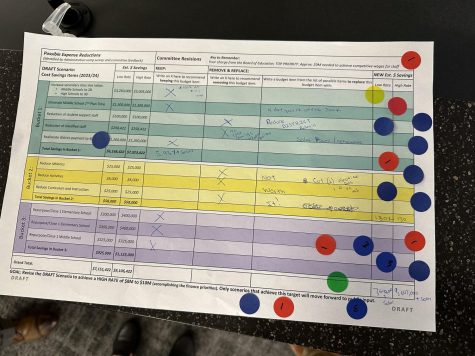District Futures Planning Committee to showcase potential budget-cut package at community meetings
Get prepared before the Futures Planning Committee public-input sessions
Students at work in the classroom of Kimberly Hawks, whose business classes last year experienced cuts
January 17, 2023
With this year’s batch of budget cuts to be finalized in mere months, the USD 497 Futures Planning Committee is narrowing in on the plan it will present to the board in February.
The Futures Planning Committee (FPC) will be showcasing a plan with up to $9.6 million in budget cuts. Last Wednesday, committee members developed their current draft of proposed cuts after beginning with a plan forwarded by district administrators. The community can now weigh in during meetings starting at 6 p.m. Jan. 17 at Free State and 6 p.m. Jan. 18 at Lawrence High.
“This is not the end-all scenario – adjustments can be made in future meetings,” the guide for Wednesday’s meeting noted of the package. “The goal of this activity is to get to a point where we support the information going forward to the public.”
The yet-to-be-approved package includes a few items of contention. Among them:
- Cutting an elective at each high school
- Closing three schools (two elementary, one middle)
- Implementing a four-day school week
- Full package below

Elective Cut
In the scenario above, the elimination of an elective would save 65,000 per position, according to resources supplied to the FPC by district administration.
While the package now includes a district administration reduction, that wasn’t in the first concept forwarded by district administrators.
Kimberly Hawks, the career and technical education chair at LHS, said the district should be wary of cutting electives or educators.
“I do not want to see teacher positions cut,” Hawks said. “I do not want to see programs cut because these directly hurt our students. Instead, I think they need to look for staff in our district who do not have any direct interaction with our students.”
Some FPC members also noted the importance of student choice and electives at the high schools.
“We need to focus on making cuts where students are not,” LHS associate principal Mark Preut said at Wednesday’s meeting. “In 20 years, kids won’t remember a chemistry experiment. They’re going to remember team experiences, playing in the band at a football game or the electives they took.”
Elementary School Cut
The committee chose to keep the administration’s plan to close or repurpose two elementary schools and one middle school. FPC members say the district hasn’t shown them any specifics* on which schools might be targeted for closure, and closure talks last year led to outspoken community opposition.
Following criteria presented by ACI Boland Architects, the committee will base closure decisions on building conditions, classroom sizing (classroom capacity efficiency) and classroom count (the number of sections per grade).
Based on efficiency standards, USD 497 has deemed its ideal elementary school to have four classrooms at each grade level.*
Preut sits on the FPC and noted that while closure could be financially beneficial, the impact on students and staff would be harmful.
“It’s hard for the kids who are there,” Preut said. “It’s hard for the students who have built those relationships, for staff members, for a community.”
Middle School Cut
In order to meet district efficiency standards for middle schools, each building should be occupied at a capacity of 85%. All four middle schools are under capacity. To reach efficiency standards, Billy Mills, Southwest and West Middle School combined would need roughly 800 students.*
Liberty Memorial Central Middle School alone would need 600 students, and FPC members have operated as if Central would be the likely choice for a middle school closure.*
LHS history teacher and former Central teacher Molly Fuller said the problems are clear when it comes to closing Central, which serves East Lawrence.
“That’s just inherently problematic,” Fuller said. “Lawrence has developed between East and West, and there’s obviously a disparity there.”
At their last meeting, most FPC members agreed that the building should be repurposed into a district office, which would include selling the ESC. The closure/repurposing of three total schools would result in roughly $1 million in savings.
Four-Day School Week
Among the most controversial items is a calendar shift to a four-day workweek. The change would save an estimated $700,000.
In a recent paper for her masters in science and education program, LHS library media specialist Kirsten Rusinak discussed various impacts of a switch, including teacher retention, student achievement and costs/inequities, while disputing the idea that the district would save a large amount.
“Because research largely debunks the theory that the adoption of four-day school weeks leads to any significant cost-saving for districts (Hill & Heyward, 2017), it is important to examine other contributing factors towards the expansion of this trend and how each looks through a sociological lens,” she wrote.
A modified calendar could also create and deepen inequities.
“In a recent study by Thompson & Ward (2022), four-day school weeks were found to lead to dips in achievement,” she continued. “Teachers will likely need more training in differentiation strategies, cooperative learning structures, and flipped classroom models in order for the students at the highest risk to benefit from the most one-on-one help from their teachers.”
Rusinak’s paper forces the question: if there are no substantial cost savings made from making a calendar shift, why change?
The item is expected to be highly debated, and FPC members expect community members to push back during the Jan. 17 and 18 meetings.
Editor’s note: Jack Ritter is a member of the Futures Planning Committee. He also contributed to the scenario that included these discussed items. Sentences marked by an asterisk * used information from Ritter’s notes and recollection of meetings and FPC discussions. After a thorough review of meeting materials before the posting of this article, The Budget has confirmed that the information is accurate.


















